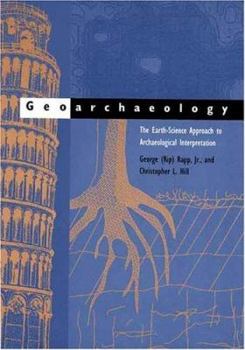Geoarchaeology: The Earth-Science Approach to Archaeological Interpretation. 2nd Edition
Select Format
Select Condition 
Book Overview
An indispensable book for all professionals and students interested in the field of geoarchaeology, including those with limited earth-science experience, this new edition of Geoarchaeology builds on... This description may be from another edition of this product.
Format:Paperback
Language:English
ISBN:0300070764
ISBN13:9780300070767
Release Date:December 1998
Publisher:Yale University Press
Length:339 Pages
Weight:1.17 lbs.
Dimensions:10.3" x 0.8" x 7.3"
Customer Reviews
3 ratings
Great read but could use more photos to illustrate concepts
Published by Thriftbooks.com User , 18 years ago
This is a superb volume. It`s interesting to read, well organized, gives a broad overview of the field, and presents illustrations of how geologists are able to contribute meaningfully to our understanding of the human past. The authors cover a broad range of subjects, including the development of the consiliance (Wilson would be proud) between archaeology and geology, that is between what might be seen as basically a "social science" and a so-called "hard science." They discuss some of the background of both disciplines, which really arose as official fields of endeavor in the 19th century, although both have significant roots in the 17th and 18th centuries. (Thomas Jefferson in the 18th century comes to mind as do Steno and Hutton). The subject of petrology---igneous, sedimentary and metamorphic---and how it contributes to an understanding of the stratigraphy of a site is very informative. The particular character of the paleoenvironment that encouraged humans to occupy a site in the first place is also very illuminating. The authors also point out the contributions of paleoclimatology, palynology, zooarchaology, fluvial systems, and other types of earth history studies that help give the reader a clearer understanding of the pre-historic and ancient historic worlds. What I found particularly interesting was their discussions of the effects of upstream erosive processes on various segments of rivers, since these are still actions in force today. The human effects on terrain become very obvious here. While the data were drawn mostly from the rivers in the United Kingdom, some material on German and French rivers and on the US Mississippi are also included. The effects of the earthquakes of 1812-1813 in New Madrid, Missouri on the Mississippi were especially amazing. (An interesting discussion of this particular event is found in When the Mississippi Ran Backwards : Empire, Intrigue, Murder, and the New Madrid Earthquakes. Information on conservation of sites provides a much clearer understanding of the problems involved in preserving a site once it has been found and its material remains exhumed. They discuss water-logged material, bog material, and modern day environmental effects on site preservation. A description of the leaning tower of Pisa and its issues was especially illustrative, since it reveals the effects of substrate on ancient buildings. Their presentation of geological data on Maya temples and the karstic substrate on which they are built made more sense of their abandonment than many other theories. The effect of site choice without an adequate understanding the effects of substrate are particularly obvious in their mention of a modern building in Mexico which has sunk several feet because of the "built" land underlying it. Like the book Alluvial Geoarchaeology: Floodplain Archaeology and Environmental Change (Cambridge Manuals in Archaeology), which I also read and reviewed, this one relies heavily on sch
The "other" five stars book on Geoarchaeology
Published by Thriftbooks.com User , 18 years ago
I have previously reviewed the book "Practical and Theoretical Geoarchaeology" by Goldberg and Macphail and I've given it 5 stars. This one is anoother five-stars book on geoarchaeology, especially since this second edition has been considerably expanded by about 80 pages. The two books are both excelent, but they possess diferent strenghts: Goldberg & Macphail's book relies heavily on landscapes, sediments, soils, stratigraphy, soil chemistry and especially soil micromorphology; it also is excelent due to coverage of field and laboratory methods. Although this focus is excelent (the book covers these topics extensively) it lets out a lot of other topics; for example, environmental studies in a archaeological context are left out (the authors consider it a separate field of study done by a separate team), and so are Archaeometric studies which the authors also consider to be out of the field of Geoarchaeology (they dedicate a chapter to some archaeometric studies, but the coverage is not only incomplete but the information is also very sparse). On the other hand, Rapp's book, although beying relatively brief in coverage of the multiple topics does cover everything that the geosciences can contribute to Archaeology, from the same topics covered by Goldberg & Macphail's book, to environmental studies and Archaeometry (like, for example, provenance studies involving trace-element patterns and stable isotopes, etc). Rapp's book is by far the most complete in terms of coverage (especially this second edition) but it is also the most brief and succint; Goldberg & Macphail's book does not cover all the ground Rapp's book covers and leaves a lot out, but on the other side it its coverage of the featured topics is much more comprehensive. All in all, two execelent books in Geoarchaeology that deserve to be each in the 5 stars pantheon; nevertheless you should be aware of the different strenghts of each one when you make your choice. If you're like me, you'll buy both.
Geoarchaeology: The Earth Science Approach to Archaeological Interpretation
Published by Thriftbooks.com User , 19 years ago
Excellent guide to geoarchaeological interpretation and processes. A must have for beginners and practisioners of archaeology.






